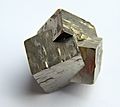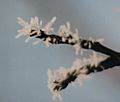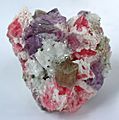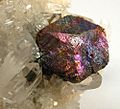Crystal facts for kids
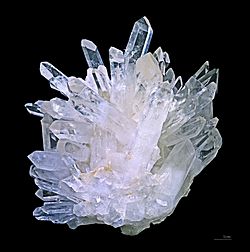
A crystal or crystalline solid is a solid material whose constituents (such as atoms, molecules, or ions) are arranged in a highly ordered microscopic structure, forming a crystal lattice that extends in all directions.
In addition, single crystals are usually identifiable by their geometrical shape, consisting of flat faces with specific, characteristics. The scientific study of crystals and crystal formation is known as crystallography.
The word crystal derives from the Ancient Greek word κρύσταλλος (krustallos), meaning both "ice" and "rock crystal", from κρύος (kruos), "icy cold, frost".
Examples of large crystals include snowflakes, diamonds, and table salt.
Occurrence in nature
By volume and weight, the largest concentrations of crystals in the Earth are part of its solid bedrock. Crystals found in rocks typically range in size from a fraction of a millimetre to several centimetres across, although exceptionally large crystals are occasionally found. As of 1999[update], the world's largest known naturally occurring crystal is a crystal of beryl from Malakialina, Madagascar, 18 m (59 ft) long and 3.5 m (11 ft) in diameter, and weighing 380,000 kg (840,000 lb).
Other rock crystals have formed from fluids, commonly water, to form quartz veins. Water-based ice in the form of snow, sea ice and glaciers is a very common manifestation of crystalline or polycrystalline matter on Earth. A single snowflake is typically a single crystal, while an ice cube is a polycrystal.
Crystallography
Crystallography is the science of measuring the crystal structure (in other words, the atomic arrangement) of a crystal. One widely used crystallography technique is X-ray diffraction. Large numbers of known crystal structures are stored in crystallographic databases.
Images for kids
-
Ice crystals
-
Vertical cooling crystallizer in a beet sugar factory.
-
Twinned pyrite crystal group.
-
The material holmium–magnesium–zinc (Ho–Mg–Zn) forms quasicrystals, which can take on the macroscopic shape of a pentagonal dodecahedron. Only quasicrystals can take this 5-fold symmetry. The edges are 2 mm long.
-
Insulin crystals grown in earth orbit.
-
Hoar frost: A type of ice crystal (picture taken from a distance of about 5 cm).
-
Gallium, a metal that easily forms large crystals.
-
Boules of silicon, like this one, are an important type of industrially-produced single crystal.
See also
 In Spanish: Cristal para niños
In Spanish: Cristal para niños







